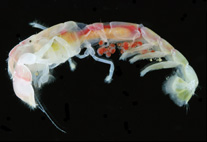Abstract
Widely distributed populations of the snapping shrimp, Alpheus floridanus Kinglsey, 1878, from the eastern Pacific and western and eastern Atlantic Ocean have long been suspected to represent different species due to extreme morphological variation among conspecifics. A companion study (Bracken-Grissom & Felder 2014) contains redescriptions of two western Atlantic species (A. floridanus Kingsley 1878 sensu stricto and A. platycheirus Boone, 1927), assignments of the original syntypes for A. floridanus, descriptions of three new species from the Atlantic and eastern Pacific (A. hephaestus Bracken-Grissom & Felder, 2014; A. roblesi Bracken-Grissom & Felder, 2014; A. ulalae Bracken-Grissom & Felder, 2014), and discussion of the relationship of the eastern Atlantic A. floridanus africanus Balss, 1916. The present study underpins all these findings by application of molecular phylogenetic techniques. Analysis of partial sequences of the 16S, 12S, and COI mitochondrial genes separate species throughout the eastern Pacific and the eastern and western Atlantic. Morphological comparisons suggested that the two syntypes of A. floridanus belong to different species, and molecular results in this study confirm this separation. Genetic data suggest a strong affinity between the western Atlantic A. platycheirus and the eastern Pacific A. hephaestus. Close relationships are evident between trans-Atlantic species, A. floridanus africanus and A. floridanus, a pattern also seen for other cryptic and pseudocryptic species of Alpheus. Alpheus roblesi and A. ulalae represent early-branching lineages within the complex. In some cases, molecular phylogenetic relationships between members of the A. floridanus complex can be reconciled with postulated biogeographic history.

